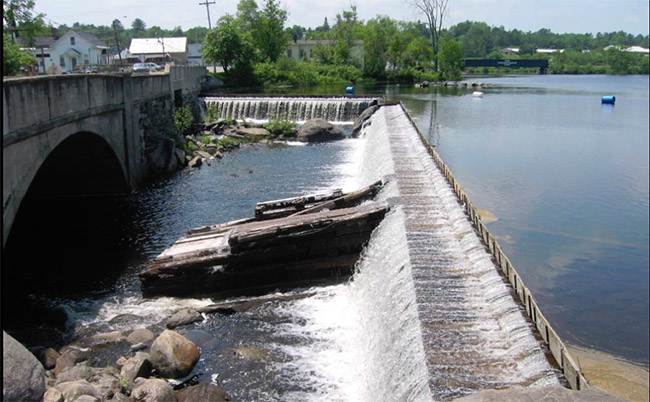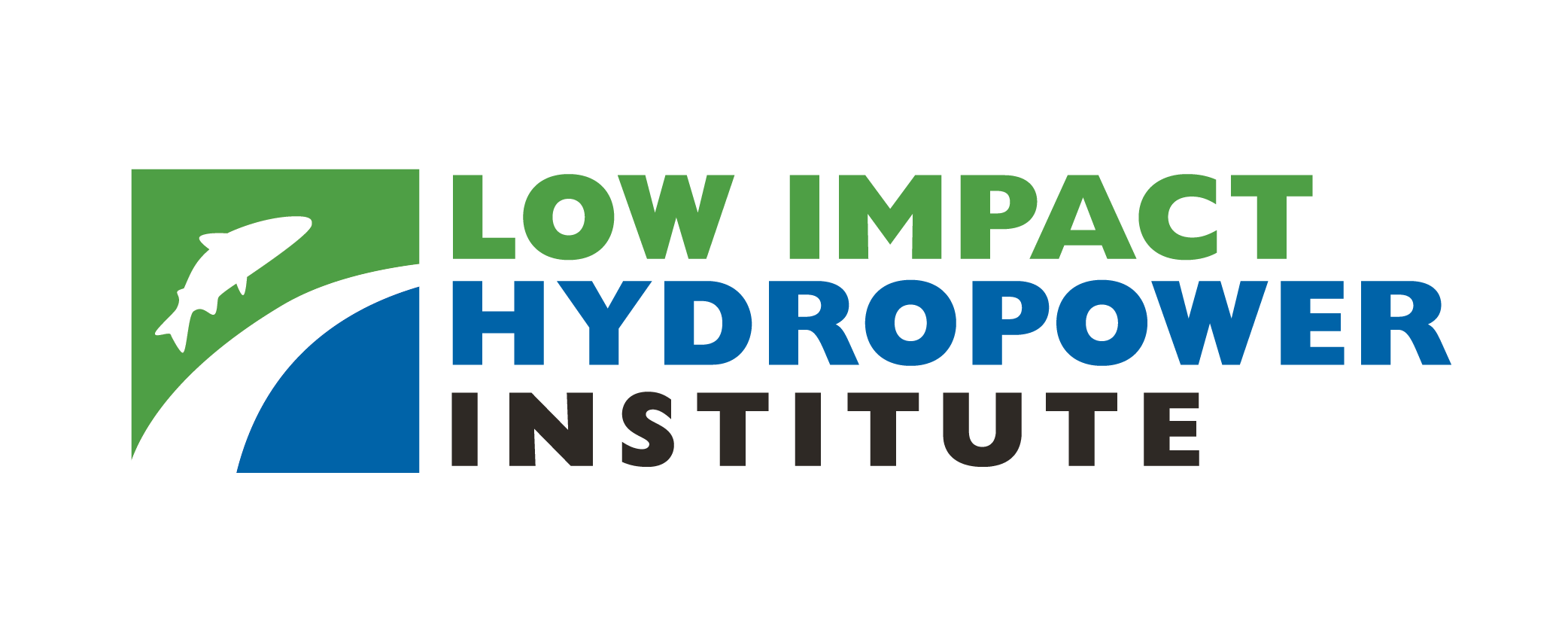LIHI 證書 #168 - Milo 項目,緬因州

| 項目名稱 | 米洛 |
| 理海證書編號 |
168 |
| LIHI 證書期限 |
2019年12月18日 – 2029年12月17日 |
| 擁有者 | KEI(緬因州)電源管理(III)有限責任公司 |
| 狀態 | 緬因州 |
| 地點 | 河哩 2
塞貝克河 |
| 裝置容量 | 0.695 兆瓦 |
| 平均年發電量 | 2,078 兆瓦時 |
| 設施類型 | 河流的奔流 |
| 聯邦能源監管委員會 不。 | P-5647,豁免 |
米洛計畫位於塞貝克河上,距離其與皮斯卡塔奎斯河交匯處上游約兩英里,位於緬因州皮斯卡塔奎斯縣米洛鎮。原版 壩 建於 1823 年,為塞貝克河沿岸的六家工廠提供動力,其中包括鋸木廠、磨坊、線軸和木棉磨坊以及毛紡廠。 1920 年,米洛電燈和電力公司在該地點安裝了兩台水力渦輪機。在接下來的十年裡,還進行了許多其他升級,並進行了全面的重新設計以適應 徑流 營運.目前的設施於 1982 年建成並於同年開始投入使用。
該項目包括一個 8 英尺高的 L 形 溢洪道 頂部有1英尺高 閃光板 由兩塊溢流岩石填充 木製嬰兒床 溢洪道段長分別為 50 英尺和 170 英尺。兩個溢洪道段的交會處有一個小型溢洪道混凝土段,以及一個動力 運河 用土堤與原有河道隔開。這 發電站 包含三台汽輪發電機組,總裝置容量為0.695兆瓦。尾水渠與原河道平行,並在下游 750 英尺處匯入。
該項目採用徑流式運行模式,蓄水 50 英畝。此專案提供的瞬時最小流量隨水道不同而變化:東水道(發電廠尾水)為 25 立方英尺/秒,西水道(旁路水道)為 50 立方英尺/秒。此要求的唯一例外是當流入大壩的水量少於 75 立方英尺/秒時,東水道的 25 立方英尺/秒流量與總流入量之間的差額會在西水道中釋放。該流動制度是與緬因州內陸漁業和野生動物部 (MDIFW) 和美國魚類及野生動物管理局協商制定的。
項目上游的水域被指定為 A 類。適合用途包括主要接觸娛樂和水生棲息地支持。大壩下方的水域由於歷史上的洪水而被指定為 B 級。大腸桿菌污染。造成損害的原因可能是合流污水溢流事件;專案運作不會對水質產生不利影響。
歷史上,美洲西鯡、鯡魚、藍背鯡、七鰓鰻、短鼻鱘、大西洋鱘和大西洋鮭等洄游魚類都沿塞貝克河逆流而上。然而,佩諾布斯科特河、皮斯卡塔奎斯河和塞貝克河下游的大壩建設阻止了這些物種遷移到該計畫區域。雖然這些物種的遷徙受到阻礙,但 MDIFW 指出,該計畫為防止北梭魚等入侵物種逆流而上創造了重要的屏障。
塞貝克湖是緬因州最初的內陸大西洋鮭魚水域之一。塞貝克湖的支流為這裡的野生陸生鮭魚族群提供了重要的產卵和育苗棲息地。如果將北梭魚引入該湖,可能會對生態系統造成極大的破壞。 2011 年,緬因州立法機構通過了 LD 134:《保護本地內陸鮭魚漁業免受入侵物種侵害的法案》。該法案明確禁止該項目的上游通道措施。這也適用於下游通道,儘管已知高流量事件會導致成年陸封鮭魚順流而下。其他常駐魚類包括湖鱒魚、白鱸魚、小嘴鱸魚、北赤腹鯪魚、梭魚、太陽魚、鱸魚、溪鰱等。
該項目土地面積約為4英畝。工程附近的土地用途包括無人居住的樹木繁茂的山丘和用於休閒娛樂的森林高地。附近有一些商業和住宅物業。經州政府授權,米洛鎮對塞貝克河沿岸的開發實施了多項限制措施,包括在湖泊和溪流的最高水位線延伸 250 英尺的緩衝區。計畫區域的大部分是內陸水禽和涉禽棲息地,為這些物種提供了重要的繁殖、覓食、遷移和越冬棲息地。
計畫附近可能存在的受威脅或瀕危物種包括北方長耳蝠、小棕蝠、東部小足蝙蝠和加拿大猞猁。計畫區域內不存在這些物種的關鍵棲息地,並且由於計畫所處的開發地點,計畫運作不太可能對這些物種產生負面影響。該計畫還承諾遵守美國魚類及野生動物管理局關於保護北長耳蝠的 4(d) 規則,主要限制在一年中的關鍵時期砍伐樹木。
計畫區域內的歷史資源包括繞過河段西岸的美國磨坊和磨坊綜合體。緬因州歷史保護委員會 (MHPC) 指出,該項目不會對任何具有歷史、建築或考古意義的建築或遺址產生影響。專案在進行任何可能影響歷史或文化資源的施工或活動之前必須諮詢 MHPC。
小型項目區域不包含任何娛樂設施,但在安全的情況下免費向公眾開放。公園附近有幾個休閒場所,提供休閒資源。退伍軍人紀念公園位於水壩上游的東岸,設有野餐區、人行道、涼亭、船坡和碼頭。多布爾公園 (Doble Park) 位於水壩上游蓄水池西岸。
合規狀態
目前證書中沒有針對設施的特定條件。
2024: 未發現重大變更或合規問題。根據年度審查,該項目仍符合規定。
2023: 未發現重大變更或合規問題。根據年度審查,該項目仍符合規定。
2022: 未發現重大變更或合規問題。根據年度審查,該項目仍符合規定。
2021: 沒有報告變更或合規問題。根據年度審查,該項目仍符合規定。
2020: 沒有報告變更或合規問題。根據年度審查,該項目仍符合規定。
2019: 目前證書的年度報告尚未生效。
認證歷史
2022 年 1 月 1 日: 根據 2022 年 1 月 1 日發布的 LIHI 第二版認證手冊第 2.05 版,LIHI 證書期限已延長。
2020年4月17日: 2020 年 4 月 15 日上訴期結束後,在無人提出上訴的情況下,對 Milo 計畫進行認證的決定成為最終決定。認證期限為2019年12月18日至2024年12月17日。
2020年3月16日:低影響水力發電研究所已初步批准對位於塞貝克河上的米洛水電項目進行低影響認證,該河位於緬因州皮斯卡塔奎斯縣米洛鎮,距塞貝克河與皮斯卡塔奎斯河交匯處上游約兩英里處。該決定是初步決定,需等待 30 天的上訴期。只有在 60 天的評論期內對初始申請發表評論的人才有資格提出上訴。此類上訴需要包括有關該項目如何不符合 LIHI 標準的解釋。申訴請求可以透過電子郵件發送至 comments@lowimpacthydro.org,並在主題行中註明“米洛水電計畫”,或郵寄至低影響水力發電研究所,地址為:329 Massachusetts Ave, Suite 6, Lexington, MA 02420。所有請求都將發佈在網站上。申請人將有機會回應,任何回應也將被公佈。申請必須在 2020 年 4 月 15 日美國東部時間下午 5 點之前收到。完整的申請和審核員報告如下。如果沒有收到上訴請求且決定成為最終決定,則該計畫的認證期限為2019年12月18日至2024年12月17日。
2020年1月3日:低影響水力發電研究所已收到米洛水電計畫低影響認證的完整申請。 LIHI 正在就此申請徵求公眾意見。具體來說,我們想知道您是否認為該項目符合第二版手冊中修訂的 LIHI 低影響認證標準。請查看 LIHI 修訂手冊中的計劃和標準,然後查看下面的專案申請資料。與特定 LIHI 標準(流量、水質、 魚道等等)將非常有幫助,但所有評論都會被考慮。您可以透過 comments@lowimpacthydro.org 向研究所提交意見,並在主題行中註明“Milo 專案意見”,或郵寄至低影響水力發電研究所,地址:329 Massachusetts Avenue, Suite 6, Lexington, MA 02420。意見必須在 2020 年 3 月 3 日美國東部時間下午 5 點或之前收到,才會被考慮。所有評論都將發佈到網站上,申請人將有機會回應。任何回應也將被發布。
